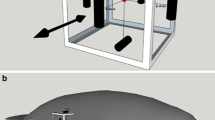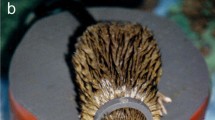Summary
-
1.
The flagellum of the second antenna of the crayfishAstacus leptodactylus has two main types of sensory hairs, normal erect hairs and procumbent hairs, which bridge the junction between adjacent segments of the flagellum (Tautz et al. 1981). The upright hairs respond to particle motion or touch, and the procumbent hairs to bending of the flagellar articulation that they span.
-
2.
Their mode of excitation suggests that the procumbent hairs might be able to detect and perhaps also locate nearby moving objects by the underwater disturbances they create. To test this idea we have developed a mathematical model that predicts the stimulation of the procumbent hairs produced by sources of different types, strengths, frequencies and axes of vibration. The model has been tested by measuring underwater antenna motion in response to a dipole source (a vibrating sphere) using laser Doppler vibrometry. The model appears to be adequate up to ∼ 30 Hz.
-
3.
We have also used a second model, based on the work of Fletcher (1978), to predict the stimulation of the upright hairs. Comparison of results from the two models suggests that the procumbent hairs generally have a larger “receptive field”, particularly beyond the tips of the antennae. The procumbent hairs may also be less affected by random background stimulation than upright hairs and would not be influenced by eddies or turbulence created by water flowing across the antennae.
-
4.
Based on our model of antenna bending and on previous neurophysiological work, the angular response threshold of procumbent hair sensilla may be <0.0003 ° at their best frequency. Thus the procumbent hair sensilla should be capable of detecting fish large enough to be potential predators at least 20 cm away.
-
5.
It is possible that a crayfish, by analyzing the pattern of stimulation produced by a source of underwater disturbances, might also be able to determine its location, restricting its position to within a certain Probable Location Region (PLR). The size and location of PLRs is affected only slightly by the source strength and frequency of vibration, but differences in source type and axis of vibration increase the size of the PLR of an unknown source. A crayfish might also determine the approximate direction to a source by moving its antennae and monitoring the change in procumbent hair stimulation.
Similar content being viewed by others
Abbreviations
- LDV :
-
laser Doppler vibrometry
- PLR :
-
probable location region
References
Bergeijk WA van (1964) Directional and nondirectional hearing in fish. In: Tavolga WN (ed) Marine bioacoustics. Pergamon Press, Oxford, pp 281–299
Chichibu S (1978) Response patterns and direction sensitivities of the crayfish setae units. Acta Med Kinki Univ 3:177–189
Chichibu S, Wada T, Komiya H, Suzuki K (1978) Structure of mechanoreceptive hairs on the crayfish first antenna. Acta Med Kinki Univ 3:27–39
Cremer L, Hedd M, Ungar EE (1973) Structureborne sound. Springer, Berlin Heidelberg New York
Fletcher N (1978) Acoustic response of hair receptors in insects. J Comp Physiol 127:185–189
Harris GG (1964) Considerations on the physics of sound production by fishes. In: Tavolga WN (ed) Marine bioacoustics. Pergamon Press, Oxford, pp 233–248
Harris GG, Bergeijk WA van (1962) Evidence that the lateral line organ responds to near-field displacements of sources in water. J Acoust Soc Am 34:1831–1841
Kinsler LE, Frey AR (1962) Fundamentals of acoustics, 2nd edn. Wiley, New York
Laverack MS (1964) The antennular sense organs ofPanulirus argus. Comp Biochem Physiol 13:301–321
Main IG (1978) Vibration and waves in physics. Cambridge University Press, Cambridge
Masters WM, Markl H (1981) Vibration signal transmission in spider orbwebs. Science 213:363–365
Mellon D (1963) Electrical responses from dually innervated tactile receptors on the thorax of the crayfish. J Exp Biol 40:137–148
Michelsen A, Larsen ON (1978) Biophysics of the ensiferan ear. I. Tympanal vibrations in bushcrickets (Tettigoniidae) studied with laser vibrometry. J Comp Physiol 123:193–203
Morse PM (1948) Vibration and sound, 2nd edn. McGraw Hill, New York
Solon MH, Kass-Simon G (1981) Mechanosensory activity of hair organs on the chelae ofHomarus americanus. Comp Biochem Physiol [A] 68:217–223
Tautz J (1977) Reception of medium vibration by thoracal hairs of caterpillars ofBarathra brassicae L. (Lepidoptera, Noctuidae) I. Mechanical properties of the receptor hairs. J Comp Physiol 118:13–31
Tautz J (1979) Reception of particle oscillation in a medium — an unorthodox sensory capacity. Naturwissenschaften 66:452–461
Tautz J, Masters WM, Aicher B, Markl H (1981) A new type of water vibration receptor on the crayfish antenna. I. Sensory physiology. J Comp Physiol 144:533–541
Taylor RC (1968) Water-vibration reception: A neurophysiological study in unrestrained crayfish. Comp Biochem Physiol 27:795–805
Taylor RC (1975) Physical and physiological properties of the crayfish antennal flagellum. J Neurobiol 6:501–519
Tazaki K (1977) Nervous responses from mechanosensory hairs on the antennal flagellum of the lobsterHomarus gammarus (L.). Mar Behav Physiol 5:1–18
Tazaki K, Ohnishi M (1974) Responses from tactile receptors in the antenna of the spiny lobsterPanulirus japonicus. Comp Biochem Physiol [A] 47:1323–1327
Tritton DJ (1977) Physical fluid dynamics. Van Nostrand Reinhold, New York
Vedel JP, Clarac F (1976) Hydrodynamic sensitivity by cuticular organs in the rock lobsterPanulirus vulgaris. Mar Behav Physiol 3:235–251
Wiese K (1976) Mechanoreceptors for near-field water displacement in crayfish. J Neurophysiol 39:816–833
Wyse GA, Maynard DM (1965) Joint receptors in the antennule ofPanulirus argus Latreille. J Exp Biol 42:521–535
Author information
Authors and Affiliations
Additional information
Dedicated to Prof. Dr. Dr. h.c. H. Autrum on the occasion of his 75th birthday
Rights and permissions
About this article
Cite this article
Masters, W.M., Aicher, B., Tautz, J. et al. A new type of water vibration receptor on the crayfish antenna. J. Comp. Physiol. 149, 409–422 (1982). https://doi.org/10.1007/BF00619156
Accepted:
Issue Date:
DOI: https://doi.org/10.1007/BF00619156




